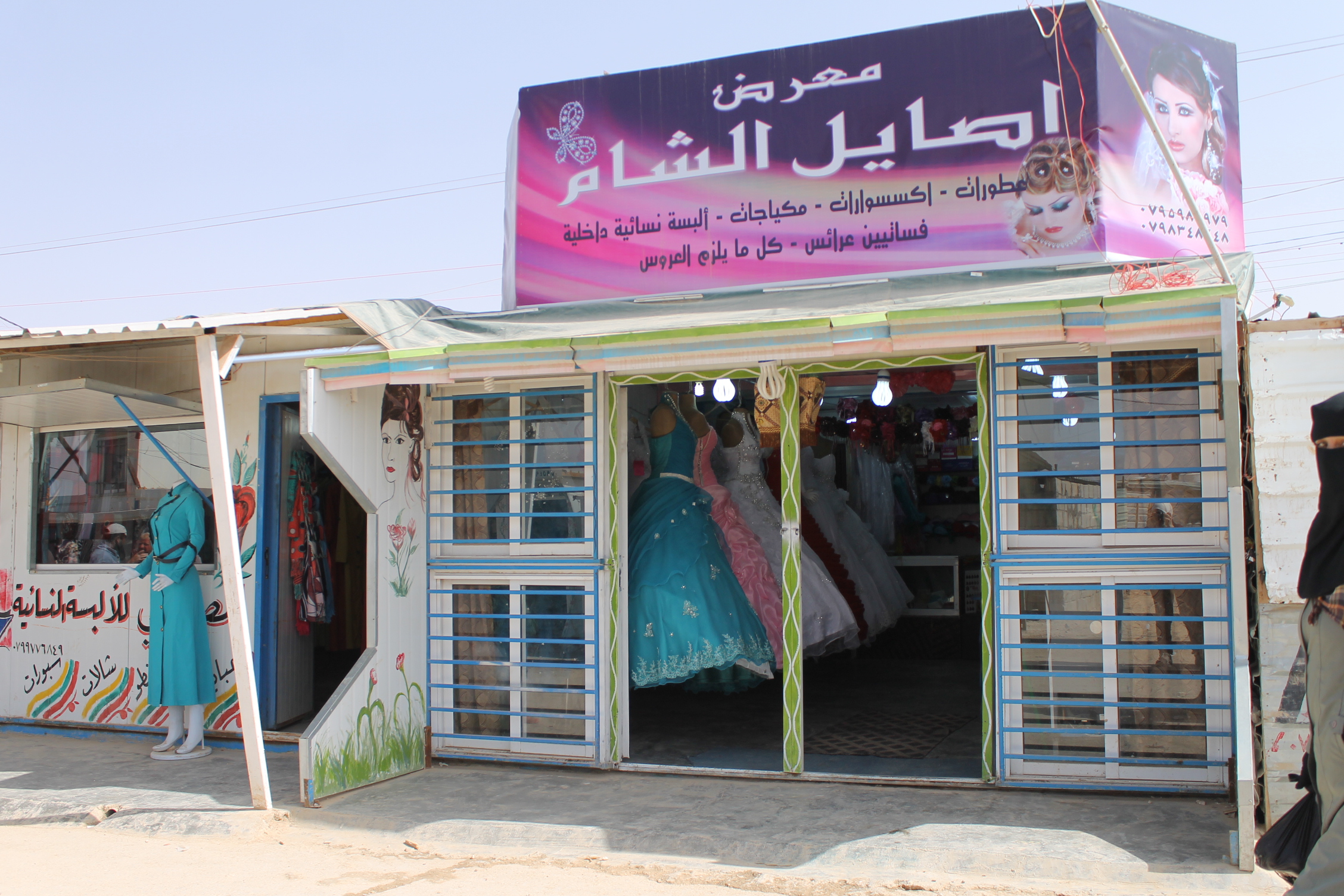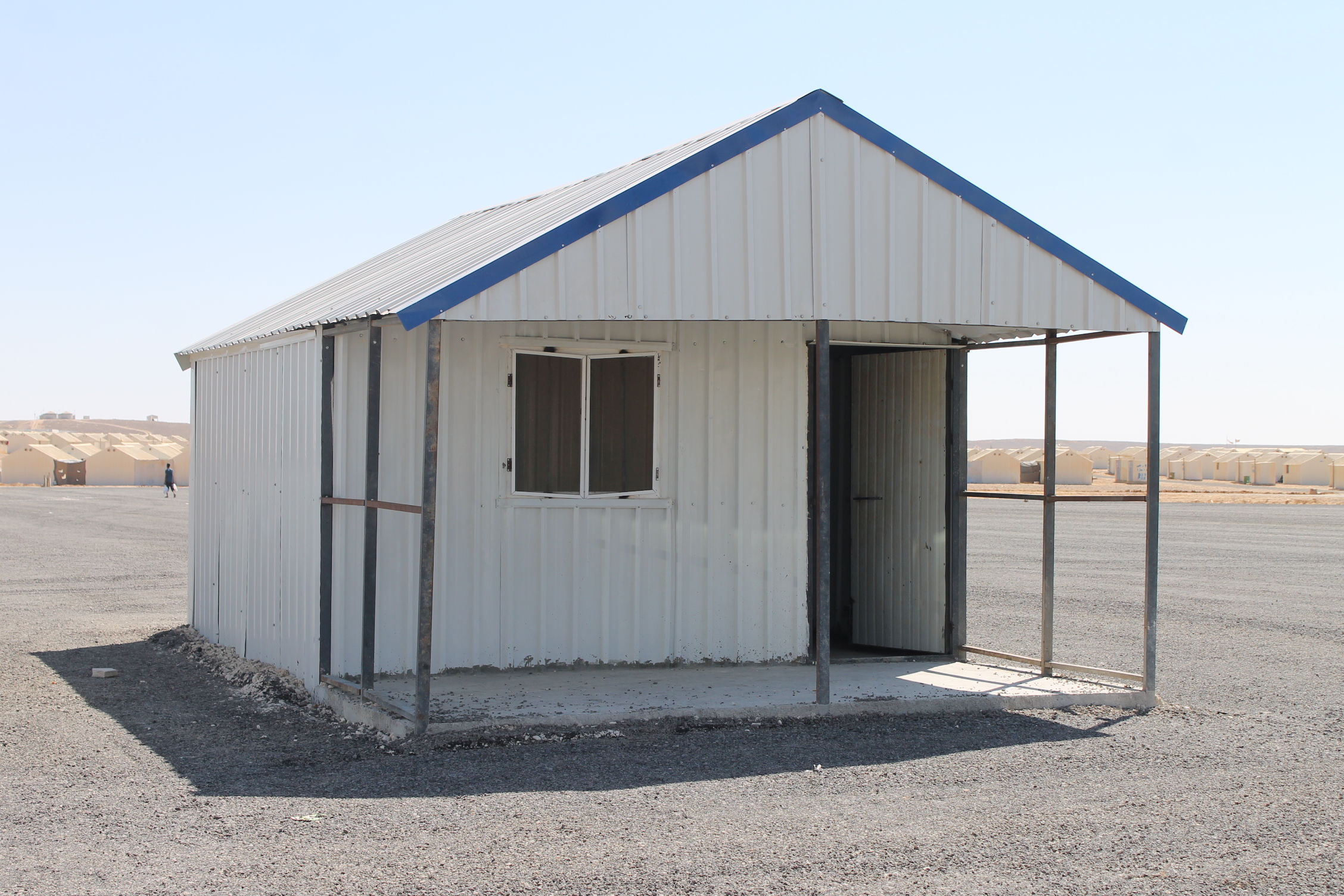The Difference a Market Makes: The Case of Syrian Refugee Camps in Jordan

A refugee camp is a place of harsh contradictions – one that is temporary yet protracted, vast yet overcrowded, and fluctuating yet stagnant. A place for the displaced, but where they are hijacked of their basic means of living.
While humans are instinctively resilient and will fight through the adversities a camp brings, their relative ease in adapting to the trying environment depends on certain life-sustaining elements. In the case of Jordan’s two main camps for Syrian refugees, economic activity has been a critical factor. The existence of a marketplace (and lack thereof) has been shaped by –and in turn, helped shape – the two noticeably contrasting ecosystems of Zaatari and Azraq Camp, in addition to making a significant difference in peoples’ ability to “settle in”.
Zaatari Refugee Camp opened in July 2012 at the onset of the Syrian crisis and is the biggest and most populated camp for Syrian refugees in Jordan. Hosting almost 80,000 refugees, it is a dense, dynamic hub of prefabricated container homes and shops that have been modified by their owners to serve their needs. These kinds of adjustments were possible because of the rapid influx and haphazard growth of the camp. While this had serious consequences, like the forming of quasi-mafias controlling certain neighborhoods, sexual and gender based violence, and sanitation problems, it also meant that people could shape their own environment. A positive outcome of this flexibility is the market street, commonly referred to as the Champs-Élysées for its axial form, vibrancy, and centrality to life in the camp. Enhanced by trade with the nearby city of Mafraq, it includes restaurants, coffee kiosks, a billiard center, a wedding dress shop, and a furniture shop. Not only does it provide the goods and services needed by the residents, but the market also serves as a pastime, place for community building, and source of income, dignity, ownership, and pride.
Not only does it provide the goods and services needed by the residents, but the market also serves as a pastime, place for community building, and source of income, dignity, ownership, and pride.
When Zaatari became overcrowded, the government decided that another camp was needed to host the anticipated influx of refugees. Opened in April 2014, Azraq Refugee Camp now has a population of almost 33,000. Unlike Zaatari, this camp was meticulously planned with shelters and amenities in place before the arrival of any refugee. While the pre-planning and design means that the camp is safer, more organized, and better regulated than its counterpart, the combination of stringent security control, the more “fixed” nature of the shelter and settlement, and distant location from the urban area has hindered people’s ability to shape their surroundings.
Moreover, although market grounds with shops have been ready for months, the market area has not been opened and the shops remain empty; the main cause seems to be hesitation from the Syrian Refugee Affairs Directorate (SRAD) – the government entity that manages the camps with the support of UNHCR government – to grant work permits and allow refugees to create an informal economic scheme as they did in Zaatari Camp. As a result, people are left with little to do, are heavily dependent on humanitarian aid, and have lost an opportunity for income and informal social interaction. It should come as no surprise that many residents of Azraq Camp have expressed the wish to be moved to Zaatari Camp. Some have even stated that they would rather go back to Syria. Currently, the main source of products is a large Jordanian-run supermarket, which has been criticized for being too expensive, not having the products people want, and for some (such as vulnerable and physically disabled individuals), difficult to reach.


The two refugee camps are almost opposites – one developed organically but carried with it the consequence of criminal activity, while the other was pre-planned and organized but lacks the informality and “incompleteness” which would allow people to make it their own. While the efforts of aid agencies to restructure and organize Zaatari over the years seem to have improved its safety, Azraq is still lagging in providing a means for economic activity, despite UNHCR’s numerous negotiations with the government. Rumor has it, however, that SRAD may have finally opened the marketplace. Time will tell if this is true. While an Incentive-Based Volunteering Program (IBV)* in Azraq Camp provides some financial relief, it is insufficient to meet all the demand for work; additionally, the IBV’s top-down approach only gives refugees the option of picking from what is offered to them, rather than allowing them to create their own economic opportunities.
A policy should be put in place that gives people the freedom to set up their own businesses in Azraq Camp, while the government and humanitarian agencies play the role of regulators rather than job providers. Furthermore, it is critical to consider economic activity beyond the borders of the camp. A means of trade with nearby cities could be a win-win situation that provides refugees access to goods and Jordanian businesses with clients. Moreover, the currently large gap between Azraq Camp and the nearest cities could be narrowed by encouraging development in the surrounding areas – essentially bringing the city closer to the camp. (While this may raise concerns about urban sprawl, it might still be worth looking into.)
There is also potential in ideas that are less conventional within the context of refugee camps, such as permaculture and entrepreneurial initiatives. The former has potential to be successful because of previous similar projects in the Jordan Valley, in addition to the fact that many of the refugees in Azraq Camp were farmers in Syria. The latter would capitalize on common skills in the refugee community, such as handicrafts, pickling, tailoring, carpentry, and embroidery.* Both permaculture and small businesses have potential to create win-win situations with Jordanian businesses and could also be considered for Zaatari.
Economic activity serves a greater purpose beyond income and a source of living. It is the heart of daily life, the pump that gives humans a sense of purpose and persistence, and a key ingredient in community resilience.
Economic activity serves a greater purpose beyond income and a source of living. It is the heart of daily life, the pump that gives humans a sense of purpose and persistence, and a key ingredient in community resilience. Without it, people can quickly feel directionless, uprooted, and unsettled – ironic and most painful for a refugee community. Thus it is of utmost importance to prioritize economic activity and employment for refugees, not only to provide them with the means to support themselves financially but also out of respect for their strength, skills, and commendable capacity to thrive.
*For more information on IBV and the skill sets in the in camp, refer to Baseline Assessment of Skills & Market Opportunities for Youth in Azraq Refugee Camp in Jordan (Page 2-4: IBV, and page 4-8: Skill Supply)
Ru’a Al-Abweh is a Master of Urban Planning student at the University of Washington. Between 2013 and 2015, she was a Senior Shelter Assistant in the Shelter and Site Planning Unit at UNHCR Jordan. During that time, Ru’a was involved in the design of the Transitional Shelter for Azraq Camp and assisted with camp planning.
Top photo: the market in Zaatari camp. All photos courtesy of Ru’a Al-Abweh.